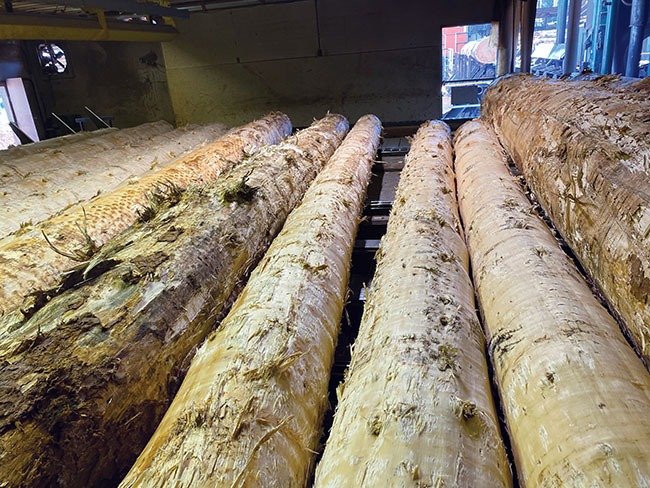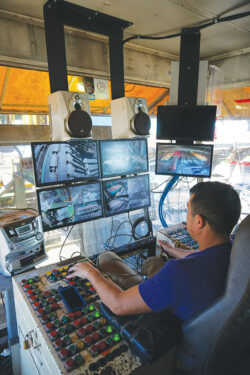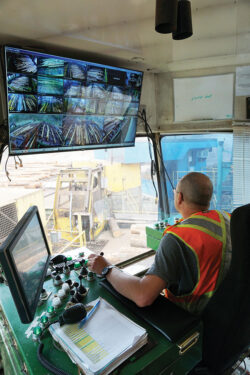
Features
Sawmill cameras that can withstand being hit by a log
May 15, 2023 By Heidi Schmidt
 Sometimes cameras get hit by logs on debarkers.
Sometimes cameras get hit by logs on debarkers. When a customer sends a message saying a camera got hit by a log, a replacement is usually in the cards. Sawmills are inherently harsh environments and electronic equipment doesn’t typically have a long life there. And yes, sometimes cameras get hit by logs on debarkers – no surprises there.
But when that message goes on to say the camera is perfectly fine and still in working condition, that is a surprise.
We know that at sawmills, equipment must endure a lot: dust, vibration, wood splinters, extreme temperature variations, and more. However, a camera getting hit by a log is something worth looking into.
The aftermath of a brutal encounter
As scientists, we’re always interested in pushing products to their limits. Cameras undergo hundreds of tests before being released to the public. Still, we know the limitations of these tests – they rarely compare with real-life situations.
But in real life, one customer’s camera took a direct hit by a log. When an outstanding incident like this happens, our scientific minds are all fired up, calculating force, pressure, speed, and more.
Luckily, the customer sent us a photo of the camera and vibration mount after the incident, and this helped us put together a case study for our research and development team. The first thing we noticed was that the bracket around the camera took most of the hit.
The bracket needed to be replaced, but that comes with a tiny cost compared to that of the camera itself and, more importantly, to the cost of interrupted feeds in a sawmill. That camera is still up and running, no replacement needed.
Camera survival

Even ruggedized cameras don’t survive being hit by a log too often. For that to happen, a few conditions must be met. Photos: Annex Business Media.
If you operate a sawmill, you’ve probably gone through a few dozen cameras already, especially if you opted for off-the-shelf equipment instead of industrial cameras. Debris-filled and high-vibration environments don’t mesh well with sensitive electronic equipment.
Cameras are some of the most delicate pieces of equipment. Their lenses are fragile and their stability, along with the quality of their feed, can easily be affected by high vibration levels, dust, humidity, and temperature variations – pretty much everything you’d find in a sawmill.
Off-the-shelf cameras fail the endurance test in sawmills in months, and sometimes weeks. Ruggedized cameras, on the other hand, are specifically created to withstand all the harsh conditions a sawmill throws at them.
Nonetheless, even ruggedized cameras don’t survive being hit by a log too often. For that to happen, a few conditions must be met.
First and foremost, the camera enclosure needs to be made of a strong alloy. Titanium works best in environments where such incidents are common. Aside from protecting the camera from mechanical shocks, the enclosure also needs to be perfectly sealed to prevent moisture from creeping in.
One of the often overlooked factors that improve the lifespan of sawmill cameras is the mount. Stabilization is extremely important in a sawmill. The high level of vibration won’t just affect the quality of the feed but also the camera’s durability and resistance to shocks.
Take the client’s example: the mount needed to be replaced, yes, but only because it took most of the hit. It was designed to do this, to soften the blow and protect the camera.
Introducing new cameras in sawmills

It’s crucial that you install industrial, ruggedized cameras that are specifically created for sawmill use. Very few other cameras can operate in these challenging conditions.
Some pieces of technology can significantly improve operations, safety, efficiency, and mitigate costs, like sawmill cameras.
Naturally, sawmill operators’ first concern is the safety of their staff. Video monitoring can help with that by spotting accidents and incidents before they happen. A continuous live feed from your sawmill can be monitored from a safe distance by an operator who can look out for issues before they shut down the line.
Operators can also look for repeat problem areas and opportunities for improvement. Is there a better way to process the lumber? Are your processes prone to accidents? How can you prevent equipment malfunction and the costly downtime associated with it?
All of these questions are far easier to answer by an operator who has the advantage of a bird’s-eye-view. But in order to get to this vantage point, you need the right video monitoring system in place.
It’s crucial that you install industrial, ruggedized cameras that are specifically created for sawmill use. Very few other cameras can operate in these challenging conditions.
But ruggedized cameras, just like any other piece of equipment, are only as good as the way you use them. Choosing the right places to install cameras is just as important as picking the right cameras. Sawmill operators should work with suppliers with a background in the logging industry who understand the challenges, constraints and opportunities of a sawmill to get the most out of any system that you install.
There are endless camera options out there and thousands of possible combinations in a video monitoring system. The advice of someone who knows the equipment well, but also the needs of a sawmill operator specifically, can make the difference between installing an ROI-generating safety-enhancing video monitoring system or a money-guzzler that needs constant replacement.
Heidi Schmidt has worked in the video technology space for almost 20 years, building expertise in CCTV, industrial video applications, new product development, video network solutions, and more. At Opticom Technologies, she helps implement robust video monitoring solutions for unique and harsh industrial environments.
Print this page